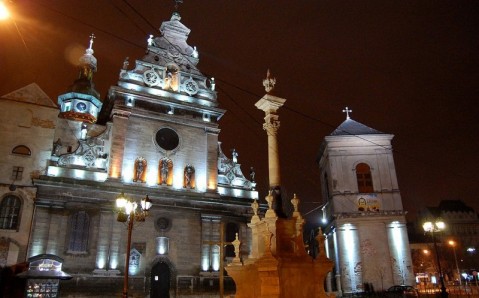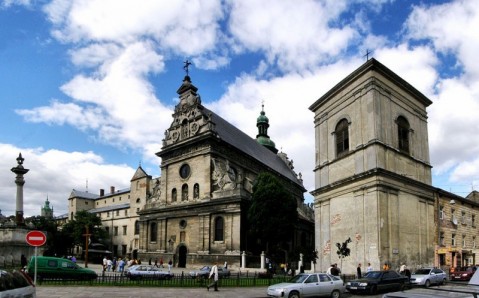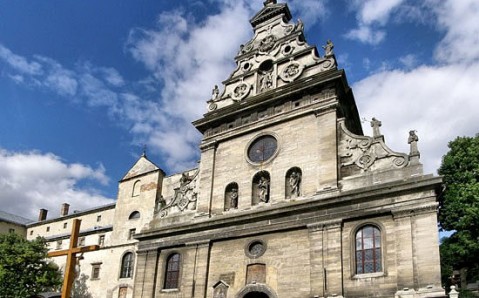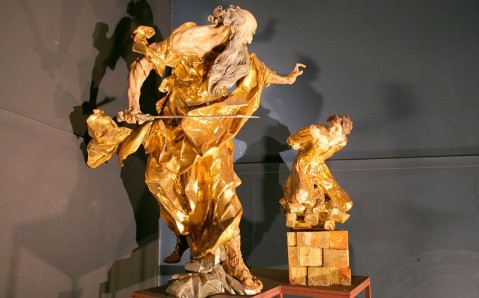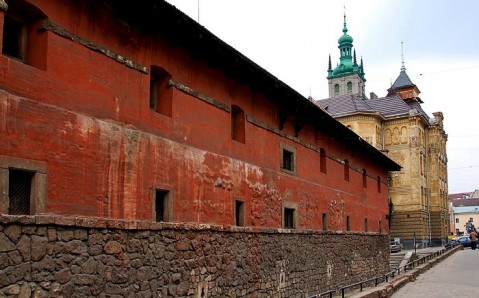Bernardine Monastery and Catholic Church
The medieval complex of the former Bernardine Monastery with the gorgeous Catholic Church of the Saint Andrew the First-Called is one of the most enigmatic historical and architectural monuments in ancient Lviv. Its magnificent, covered with multitude of legends, buildings invariably arrest attention and cause admiration of everyone strolling through Old Town.
Bernardine monks came to Lviv in the 15th century and built small wooden temple outside the town walls. They started building monastery around it, but the cloister was soon burnt down by Orthodox believers, who were against missionary activity of the western monks. In the early 17th century, by approbation and under protection of the Polish King Sigismund III, Bernardines started building a new - this time stone - monastic complex.
The monastery was of high strategic importance: the dangerous route, along which Tatar hordes and Turkish troops approached Lviv, lay right outside its walls and the Bernardine cloister was the first to take enemy's attacks upon itself. Well-fortified monastery was a part of town's fortifications - it was surrounded by thick defensive walls with stern towers and loopholes; the deep ditch and high dirt walls served as outer defense. Only one tower survived until now - the Glinyanskaya Tower with adjoined defensive wall's fragment.
The Catholic Church was Bernardine monastic architectural complex's center. It was designed by local monk, and built consecutively by three architects. Therefore, several styles interwove in temple's appearance, with Italian Renaissance being dominant one. Multi-faceted style - strict, virtually ascetic bottom is opposed by pretentiously decorated top - is the Bernardine Church's main salt.
Temple's facade is decorated by figures of Bernardine order's main saints, and by sculptures of Mother of God and Apostles Peter and Andrew. Catholic Church's interior is also exquisitely decorated. It is carried out in baroque style and is notable for ornamental forms. 18th century's wooden altars and skillful wall paintings, made by talented artists of that time, are particularly charming.
Elegant 38-meter high bell tower adjoins the church. In the year 1753, striking clock was installed on it. This clock always goes exactly five minutes forward, but not because of fallacious mechanism. It is sort of a tribute to the unknown monk who saved Lviv during Tatar siege. As the legend has it, once late at night, some Bernardine monk, who watched over the clock, ascended the tower and saw that a nomad order approaches town gates. He shouted to wake up dozing gate guards, but they didn't hear him. Then, the monk set the clock forward five minutes - exactly on the time, when main gates were shut, and thereby saved the town.
Together with the church monastic cells with adjoined household buildings were constructed. The square building formed the courtyard, where rotunda was built over the well. It was an open arched arbour, crowned with a dome, where ancient painting survived. Despite its beauty, rotunda blows cold. And there is no surprise in that: according to legend, the monks threw down bodies of betrayers - who during town's siege by hetman's troops intended to let Bohdan Khmelnitsky in Lviv - in the well.
The Bernardine Catholic Church is particularly beautiful in the evening and at night - when it is illuminated with colorful lights.

 Western
Western
